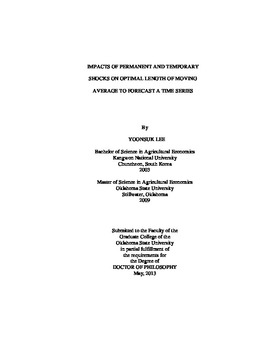| dc.contributor.advisor | Brorsen, B. Wade | |
| dc.contributor.author | Lee, Yoonsuk | |
| dc.date.accessioned | 2014-09-24T14:16:35Z | |
| dc.date.available | 2014-09-24T14:16:35Z | |
| dc.date.issued | 2013-05 | |
| dc.identifier.uri | https://hdl.handle.net/11244/10972 | |
| dc.description.abstract | Moving averages are often used for forecasting and the optimal length of the moving average depends on the size and frequency of structural breaks. A new time series model is proposed to describe permanent shocks related to structural breaks and temporary shocks with probability distributions. In the proposed model, permanent shocks are captured by a Poisson-jump or a Bernoulli-jump process, and temporary shocks are independent and identically normally distributed. This model requires a time series to have negative autocorrelation created by overdifferencing the temporary shocks. The proposed model is adapted to allow for positive autocorrelation by permitting autocorrelation of the jump process. The models are estimated with Oklahoma hard red winter wheat basis, Illinois corn basis and soybean basis, money stock, stock prices, total employment and total unemployment rate macroeconomic series. The parameters of the models are the probability of occurrence of jumps, the variance and the mean of the jump process, a time trend, and the variance of temporary shocks. The parameters are estimated with generalized method of moments estimation. In order to deal with autocorrelation in each series, we add an additional moment condition about autocorrelation to the generalized method of moments estimation. Most shocks are permanent shocks. The findings imply that shorter moving averages are the best for forecasting these series. The developed models are used to estimate the relative impacts of permanent and temporary shocks on the optimal length of moving average to use for forecasts. One year is the optimal length due to the large proportion of permanent shocks occur. The autoregressive integrated moving average (ARIMA) model with outliers is selected as a competing model. The proposed models for both a Poisson-jump model and a Bernoulli-jump model fit actual series better than the competing ARIMA models with outliers. | |
| dc.format | application/pdf | |
| dc.language | en_US | |
| dc.rights | Copyright is held by the author who has granted the Oklahoma State University Library the non-exclusive right to share this material in its institutional repository. Contact Digital Library Services at lib-dls@okstate.edu or 405-744-9161 for the permission policy on the use, reproduction or distribution of this material. | |
| dc.title | Impacts of permanent and temporary shocks on optimal length of moving average to forecast a time series | |
| dc.contributor.committeeMember | Adam, Brian | |
| dc.contributor.committeeMember | Devuyst, Eric | |
| dc.contributor.committeeMember | Kim, Jaebeom | |
| osu.filename | Lee_okstate_0664D_12772.pdf | |
| osu.accesstype | Open Access | |
| dc.type.genre | Dissertation | |
| dc.type.material | Text | |
| thesis.degree.discipline | Agricultural Economics | |
| thesis.degree.grantor | Oklahoma State University | |
